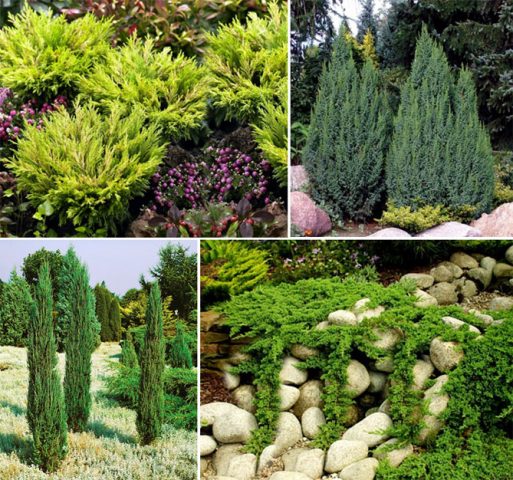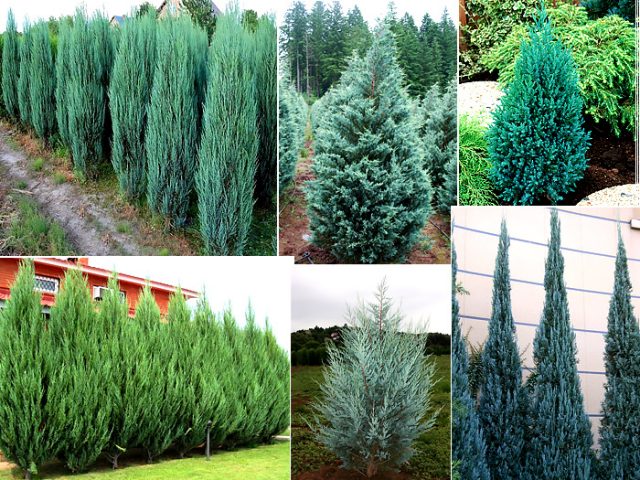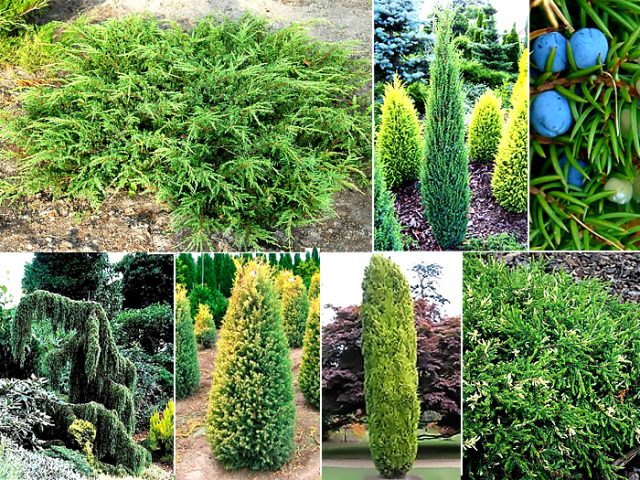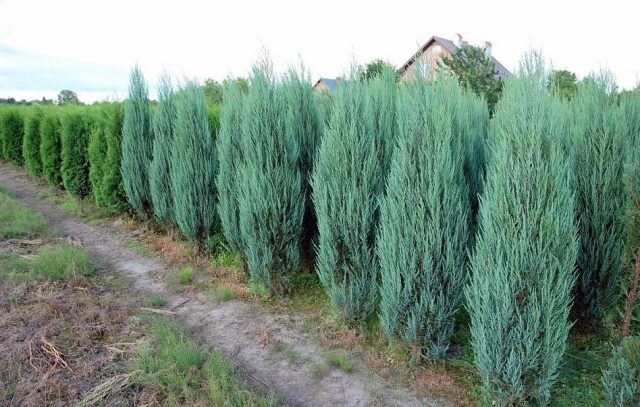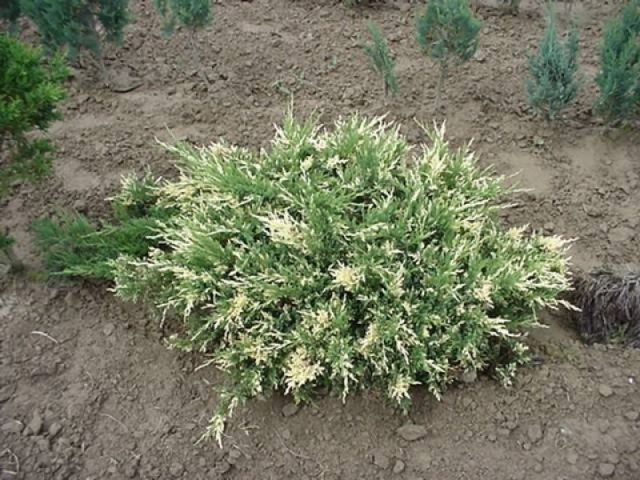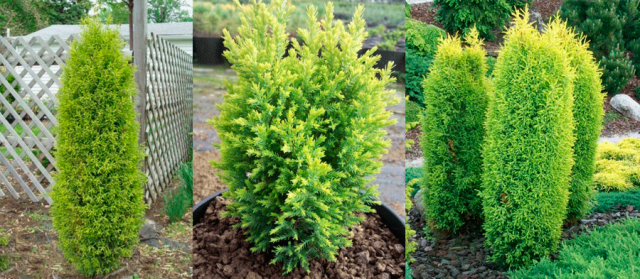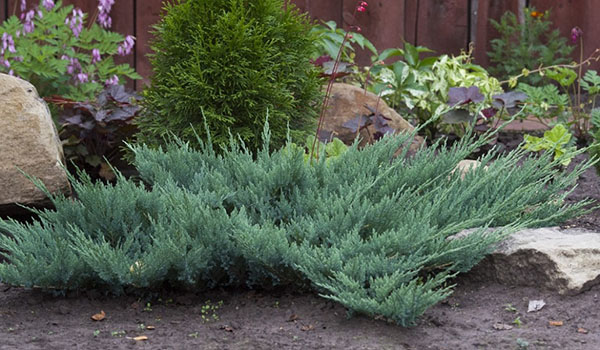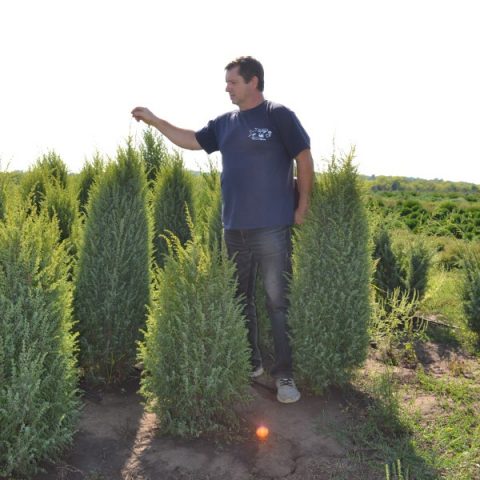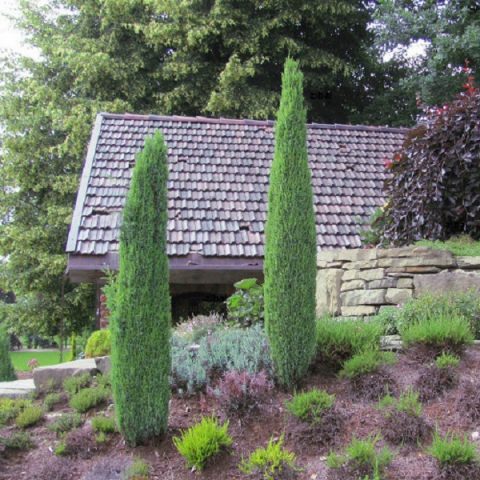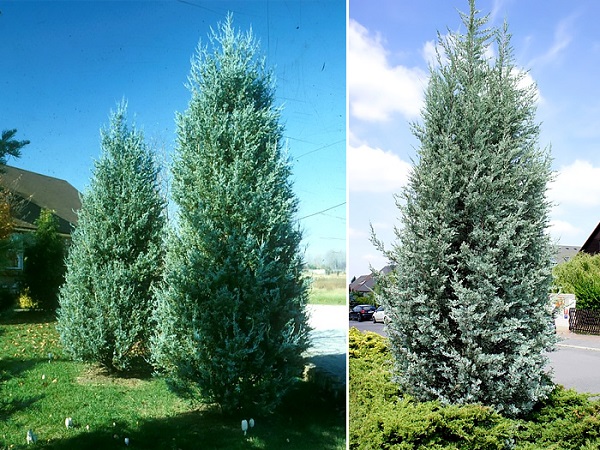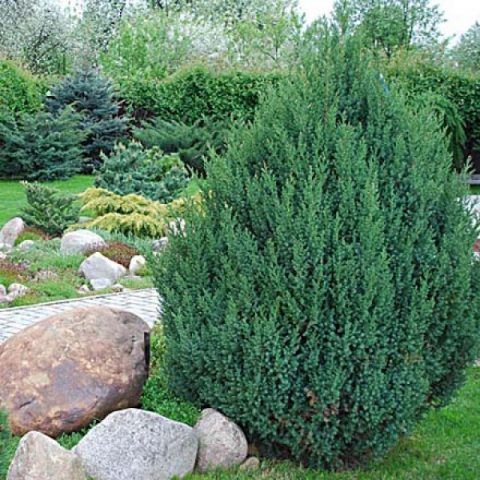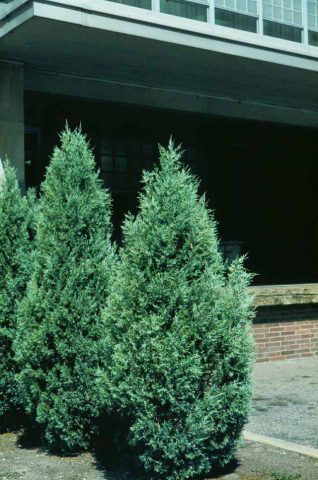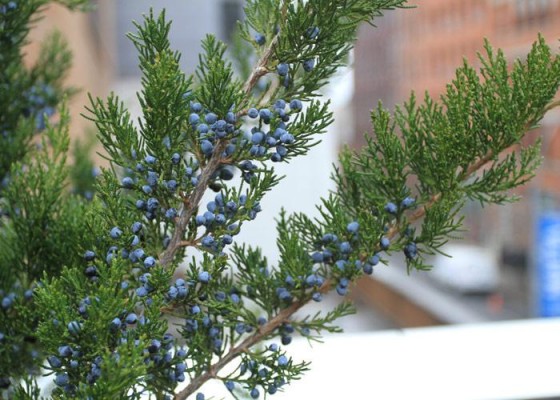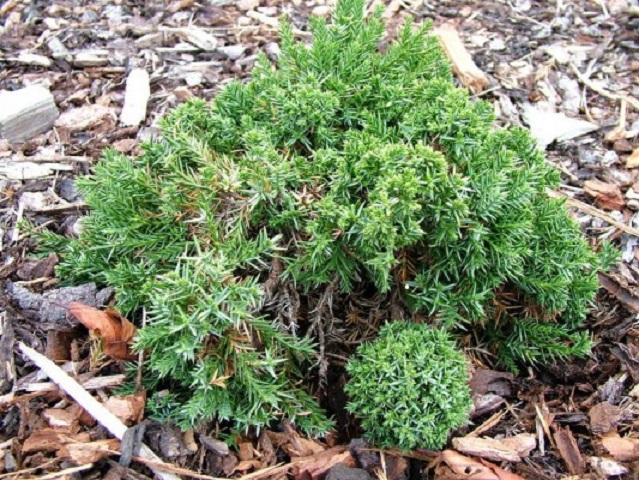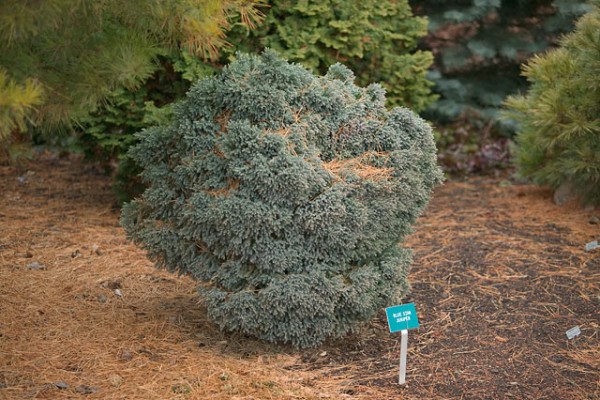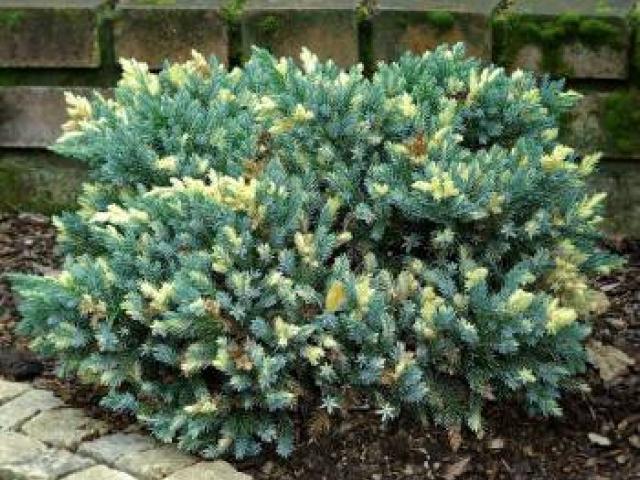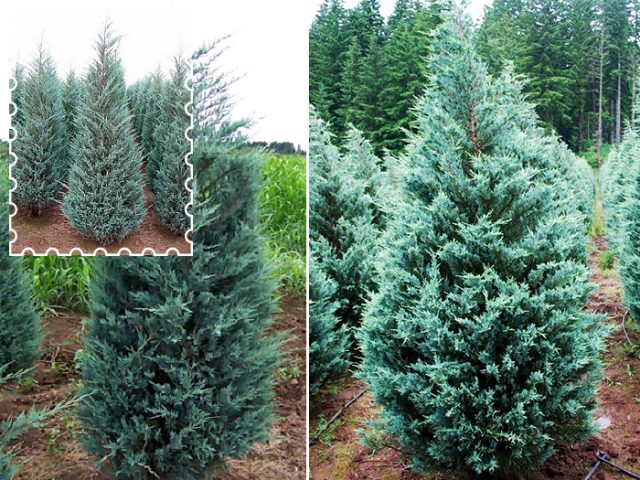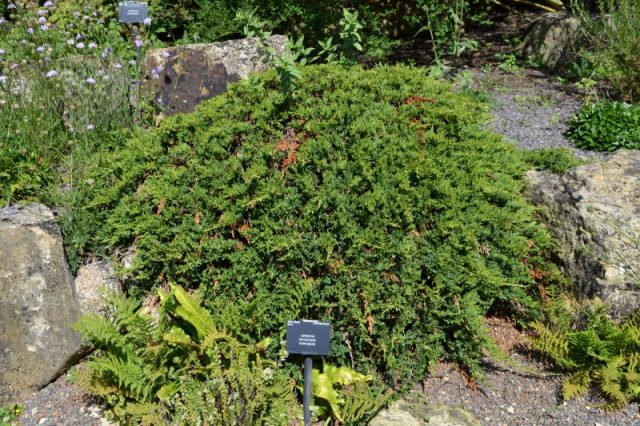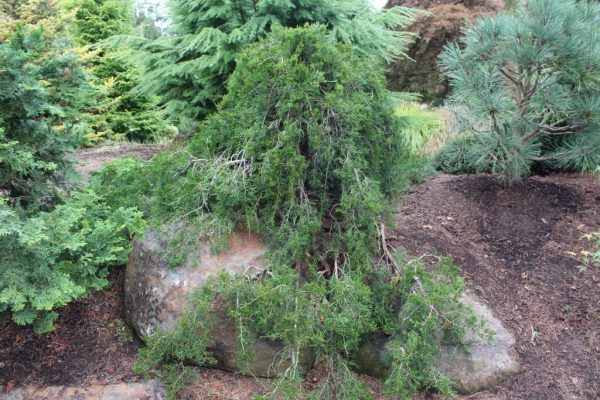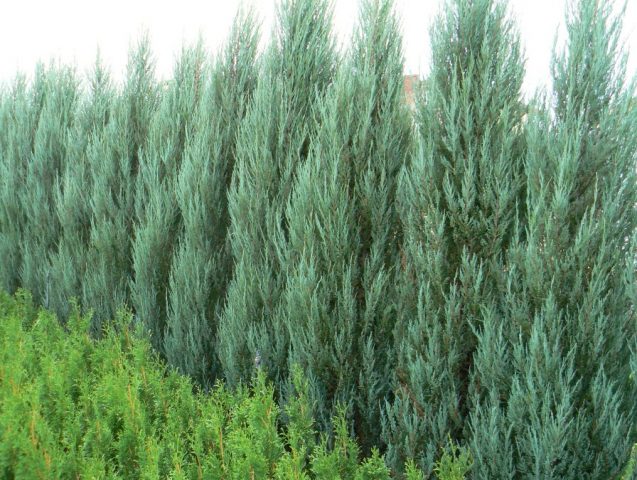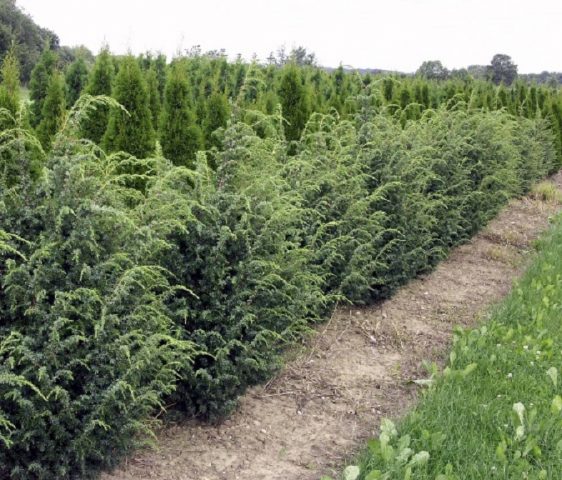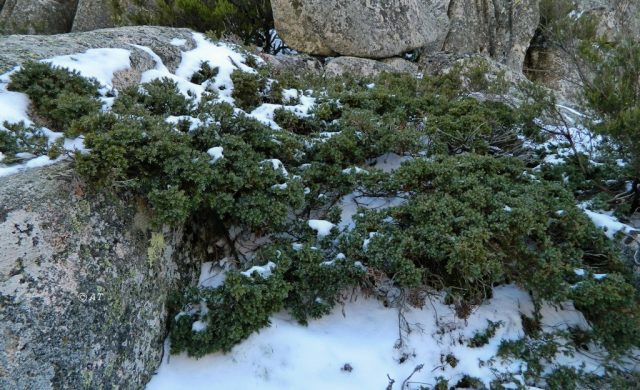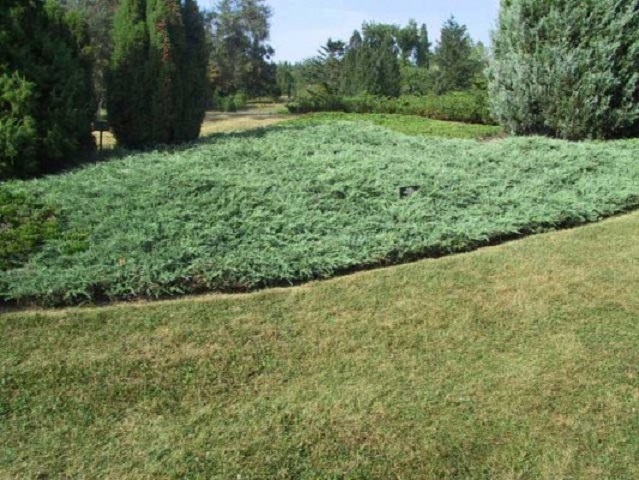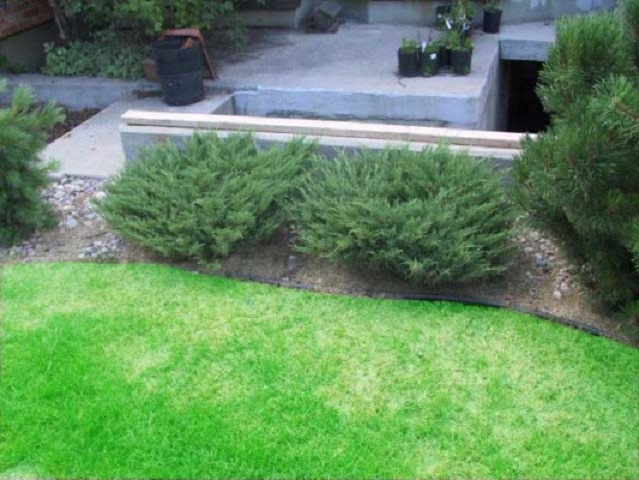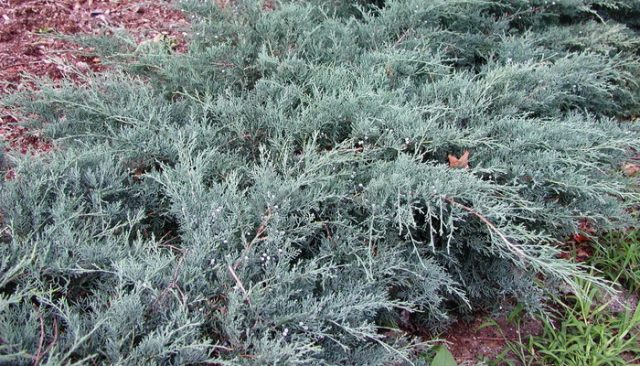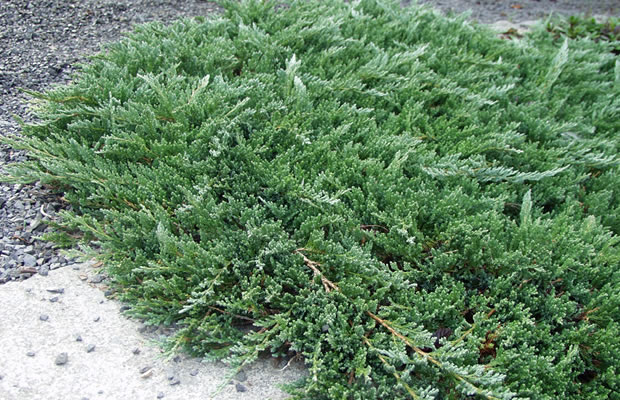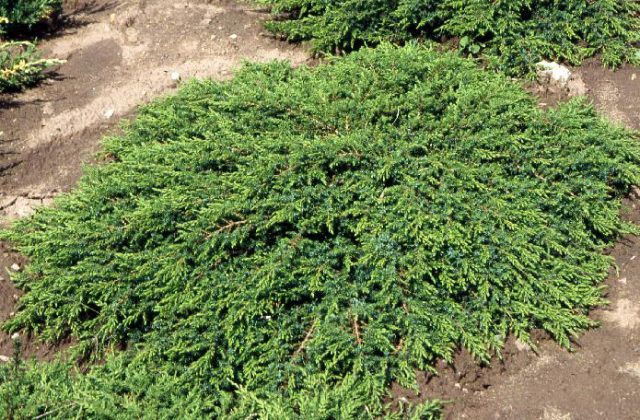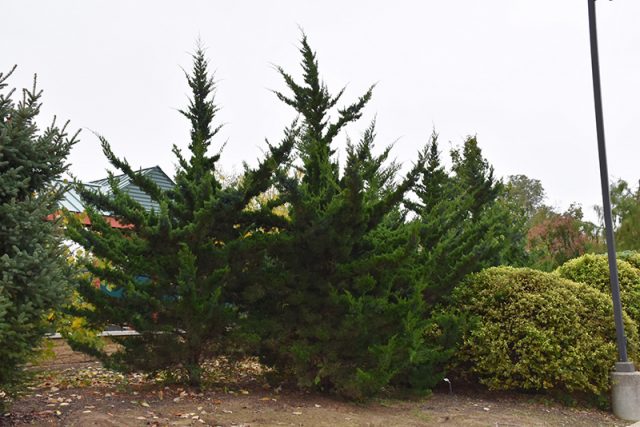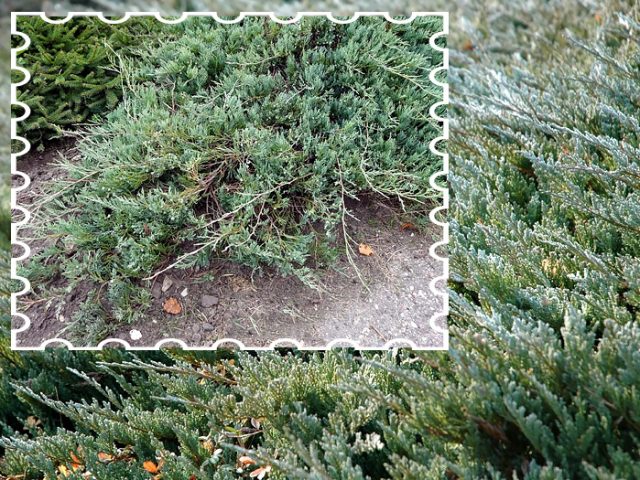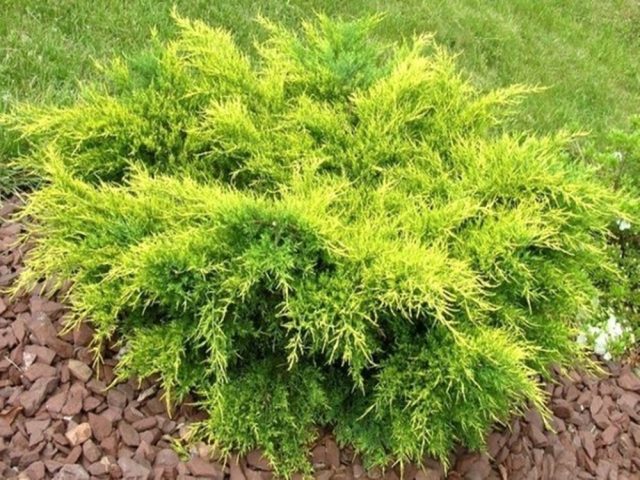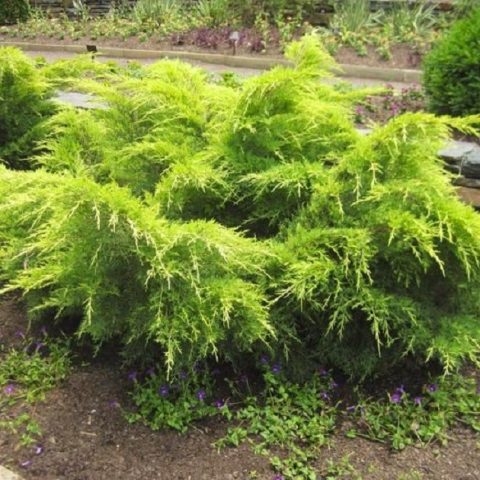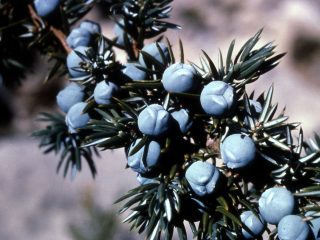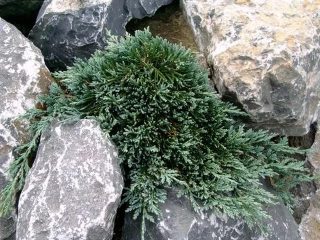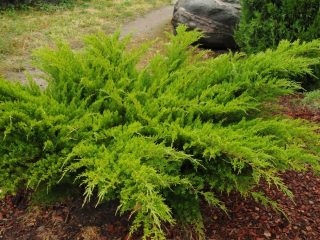Content
The types and varieties of juniper with a photo and a short description will help the owners of personal plots in choosing plants for the garden. This culture is hardy, decorative, does not impose such requirements on growing conditions as other conifers. She is unusually diverse. The garden can be filled with some different types of junipers, and still, with the skillful selection of varieties, it will not look monotonous.
What is a juniper
Juniper (Juniperus) is a genus of evergreen conifers belonging to the Cypress family (Cupressaceae). It includes more than 60 species distributed throughout the Northern Hemisphere. An exact figure cannot be given, since the classification of junipers is still controversial.
The area stretches from the Arctic to tropical Africa. Junipers grow as undergrowth of coniferous and light deciduous forests, form thickets on dry rocky hills, sands, mountain slopes.
The culture is undemanding to soils, a powerful root can extract the nutrients and moisture necessary for the plant from great depths or poor soil. All types of junipers are unpretentious, drought tolerant, grow well in full sun, but put up with partial shade. Most are highly frost-resistant, capable of enduring -40 ° C without shelter.
The age of species junipers can be hundreds and thousands of years. The varieties live much shorter. In addition, the duration of their existence is strongly influenced by their low resistance to anthropogenic pollution.
In different types of juniper, the plant can be:
- a tall tree with a size of 20-40 m, like the Juniper of Virginia;
- shrub with long branches spreading on the ground, for example, horizontal and recumbent junipers;
- a medium-sized tree with several trunks, reaching 6-8 m by the age of 30 (Common and Rocky juniper);
- shrub with ascending straight or drooping branches up to 5 m long, including the Cossack and Sredny junipers.
The culture's juvenile needles are always prickly, 5-25 mm long. With age, it can remain completely or partially sharp, or change to scaly, which is much shorter - from 2 to 4 mm. In such ornamental juniper species as Chinese and Virginia, one mature specimen grows needles of both types - soft scaly and prickly needle. The latter is more often located at the top or ends of old shoots. Shading also contributes to the preservation of the juvenile form of leaves.
The color of the needles differs not only in different types of junipers, it changes from variety to variety. The culture is characterized by color from green to dark green, gray, silvery. Often, which is especially clearly seen in the photo of decorative junipers, the needles have a pronounced blue, blue or golden hue.
Trees can be monoecious, in which the female and male flowers are located on the same specimen, or dioecious. In these species of junipers, anthers and cones are found on different plants. It is noteworthy that female specimens usually form a wide spreading crown, and male specimens - narrow, with closely spaced branches.
Round-shaped cones, depending on the type, can have a diameter of 4-24 mm, from 1 to 12 seeds. To mature, they need 6 to 16 months after pollination. Most often, the fruits are colored dark blue, sometimes almost black, covered with a bloom of a bluish tint.
There are many varieties of junipers, photos and names of which can be found on the Internet or reference books. It is impossible to mention everything in one article. But it is quite possible to give a general idea of the culture for novice gardeners, and to remind experienced ones about the variety of junipers, to help find a suitable variety for the garden.
Don't forget about juniper hybrids. Most often, virgin and rocky interbreed in nature at the border of the population. The most successful, perhaps, is Juniperus x pfitzeriana or Middle Juniper (Fitzer), obtained by crossing Cossack and Chinese, and gave many excellent varieties.
The best varieties of juniper
Of course, this is a matter of taste. But the varieties of juniper proposed for consideration with photos and descriptions are often used in the design of public and private gardens, and are popular all over the world.
Rocky juniper Blue Arrow
One of the most popular varieties, Juniperus scopolorum Blue Arrow or Blue Arrow, was bred by American breeders in 1949. It is characterized by a narrow cone-shaped crown, densely growing shoots raised up.
By the age of 10, the juniper reaches a height of 2 m, a width of 60 cm. It keeps its shape well without pruning.
Juvenile needles are needle-like, on mature trees they are scaly, green with a distinct blue tint.
It is widely used in landscaping areas as a vertical accent. Blue Arrow is planted as part of landscape groups; trees of this variety can be used to create an alley or hedge.
Hibernates without shelter in the frost resistance zone 4.
Cossack juniper Variegata
The tips of the shoots of Juniperus sabina Variegata are white or cream colored, which fades when planted in partial shade. Juniper grows slowly, in 10 years it reaches 40 cm, and about 1 m wide. The height of an adult bush is 1 m, the crown diameter is 1.5 m.
The branches are spreading, almost horizontal, but rarely come into contact with the ground, only at the base of the plant. The ends of the shoots are raised.
The variety tolerates low temperatures well, but the white tips can freeze slightly. Returning frosts are especially disliked by the young growth. In order not to spoil the appearance, the frozen needles are cut off.
Common juniper Gold Cohn
In Germany, in 1980, the Juniperus communis Gold Cone variety was created, which has a rare golden-green color of needles. The branches point upwards, but are rather loose, especially at a young age.The crown has the shape of a cone, rounded at the top. With uniform care, that is, if years of increased care are not replaced by a complete lack of attention, it keeps its shape well without scraps.
The variety has an average vigor of growth, adding 10-15 cm per season. The height of a 10-year-old tree is 2-3 m, the diameter of the crown is about 50 cm.
Prefers planting in the sun. In partial shade, the Gold Con variety loses its golden color and becomes just green.
Horizontal Juniper Blue Chip
The name of the variety is translated as Blue Chip. The juniper has earned its popularity thanks to its beautiful, neatly shaped crown spread on the ground, and bright blue needles.
This ornamental shrub grows slowly for junipers, adding 10 cm each year. It can reach a height of 30 cm, spread out to 1.2 m in width. The crown looks quite compact, keeps an attractive shape without pruning.
Shoots spread along the surface of the soil, the ends are slightly raised. Dense scaly needles change blue to purple in winter.
Hibernates in zone 5.
Chinese Juniper Obelisk
The famous Juniperus chinensis Obelisk variety was bred in the Boskop nursery (Netherlands) in the early 30s of the 20th century when sowing seeds obtained from Japan.
It is a branched tree with a conical crown at a young age with a sharp top. Every year, the height of the Obelisk variety increases by 20 cm, reaching 2 m by the age of 10, with a width at the base of up to 1 m.
Later, the growth rate of the juniper slows down. At the age of 30, the height is about 3 m with a crown diameter of 1.2-1.5 m. The tree becomes like a wide slender column with an irregular crown.
Shoots grow at an acute angle upward. Mature needles are tough, sharp, bluish-green, young needles are bright green.
Winters without shelter in zone 5.
Vertical juniper varieties
Varieties of many types of junipers have an upward crown. It is noteworthy that almost all of them belong to monoecious plants, or male specimens. High varieties of juniper with a narrow straight or wide-pyramidal crown are always popular. Even in a small garden, they are planted as a vertical accent.
Common juniper Sentinel
The name of the Juniperus communis Sentinel variety translates as sentry. Indeed, the plant has a very narrow vertical crown, rarely found in junipers. The variety appeared in the Canadian nursery Sheridan in 1963.
An adult tree grows 3-4 meters in height, while its diameter does not exceed 30-50 cm. The branches are vertical, dense, located close to the trunk. The needles are prickly, the growth is bright green, the old needles become dark and acquire a bluish tint.
The variety has a very high frost resistance - zone 2 without shelter. The tree can be used to create topiary forms.
Rock Juniper Blue Haven
The name of the American cultivar Juniperus scopulorum Blue Heaven, created in 1963, is translated as Blue Sky. Indeed, the color of the juniper needles is unusually bright, saturated, and does not change throughout the season.
Annual growth is about 20 cm, by the age of 10, the height is 2-2.5 m, and the diameter is 0.8 m.Old specimens reach 4 or 5 m, width - 1.5 m. wood. It needs to be fed more intensively than other varieties. Frost resistance is the fourth zone.
Chinese strickt juniper
One of the most popular juniper varieties in the post-Soviet space is Juniperus chinensis Stricta, bred in 1945 by Dutch breeders.
Numerous ascending, evenly spaced branches form a symmetrical, narrow-headed crown with a sharp top. The variety has an average vigor and grows 20 cm annually.By the age of 10, it reaches a height of up to 2.5 m and a width of 1.5 m at the base of the crown.
The needles are only needle-like, but rather soft, bluish-green on top, the lower part is whitish, as if covered with frost. In winter, it changes color to gray-yellow.
Trees belonging to the variety live in urban conditions for about 100 years.
Virginia Juniper Glauka
The old Juniperus virginiana Glauca cultivar, which remains popular in France since 1868, was first described by E.A. Carriere. For more than a century and a half, it has been cultivated by many nurseries, and has undergone some changes.
Now, under the same name, different manufacturers sell trees with a narrow pyramidal or columnar lush crown, beyond which individual branches often protrude. This makes the juniper appear wider than it is.
The variety grows quickly, an adult tree reaches 5-10 m with a diameter of 2-2.5 m. A distinctive feature is young silvery-blue needles, which eventually turn blue-green. On adult plants, the needles are scaly, only in the shade or inside a dense crown remain sharp. In the northern regions, the needles acquire a brown hue in winter.
Virginia Juniper Corcorcor
In Russia, the Juniperus virginiana Corcorcor variety is rare, as it is relatively new and is protected by a patent. Created in 1981 by Clifford D. Corliss (Brothers Nursery Inc., Ipswich, MA).
The cultivar is similar to the original variety, but has a dense, wide column-like crown, dense branches and more slender forms. According to the patent, the cultivar has twice as many side branches, they are much thicker.
Young needles are emerald green, with age they fade a little, but remain shiny and do not acquire a gray tint. The needles hold much longer than that of the species, without exposing the branches.
After 10 years, Korkoror reaches a height of 6 m and a diameter of 2.5 m. A hedge or alley can be grown from trees, but it is not recommended to plant as a tapeworm.
Variety Korkoror is a female fruit-bearing plant propagated only by cuttings. Seeds can be germinated, but seedlings do not inherit maternal traits.
Globular juniper varieties
This form is not typical for junipers. Small young plants can have it, but when they grow, most often the shape of the crown changes. And then it is difficult to maintain them even with a regular haircut.
But the round shape is very attractive for the garden. Juniper species with names and photos capable of supporting a more or less spherical crown are described below.
Chinese Juniper Ehiniformis
The dwarf variety Juniperus chinensis Echiniformis was created in the late 80s of the 19th century by the German nursery SJ Rinz, located in Frankfurt. It is often found in Europe, but sometimes incorrectly refers to the communis species.
Forms a rounded or flattened-spherical crown, from which branches growing in different directions are knocked out. A clear configuration can be achieved with regular pruning.
Shoots are dense and short, needles inside the crown are needle-like, at the ends of the shoots - scaly, bluish-green. It grows very slowly, adding about 4 cm per season, by the age of 10 it reaches a diameter of 40 cm.
The variety is clearly derived from a witch's broom, propagates only vegetatively. Frost resistance - zone 4.
Blue Star Scaly Juniper
Juniperus squamata Blue Star originated from a witch's broom found on the Meyeri variety in 1950. It was introduced into the culture by the Dutch nursery Roewijk in 1964. The name of the variety is translated as Blue Star.
Blue Star grows very slowly - 5-7.5 cm per year, by the age of 10 it reaches about 50 cm in height and 70 cm in width. The sizes are named rather conditionally, since the shape of the crown is difficult to determine precisely. It is sometimes called "flaky", and this is perhaps the most accurate definition.
The Blue Star variety branches in layers, and where they go depends on many factors, including pruning. Crohn can be spherical, cushion, stepped, and not amenable to any definition.But the bush looks invariably attractive and original, which only adds to the popularity of the variety.
The needles are sharp, hard, steel-bluish color. Frost resistance zone - 4.
Scaly Juniper Floreant
Juniperus squamata Floreant is a mutation of the famous Blue Star, and is named after a Dutch football club. Frankly, it does not look very much like a ball, but it is difficult to expect more rounded outlines from a juniper.
Floreant is a dwarf bush with dense short shoots that form a ball of irregular shape at a young age. When the plant reaches maturity, the crown spreads out and becomes like a hemisphere.
Juniper Floreant differs from the parent variety Blue Star in its variegated needles. The young growth is creamy white and looks great on a silver-blue background. If we consider that the shoots stick out unevenly, and light spots are scattered chaotically, then each bush becomes unique.
At the age of 10, it reaches a height of 40 cm with a diameter of 50 cm. Frost resistance - zone 5.
Common juniper berkshire
It is difficult to call Juniperus communis Berkshire a ball. The variety is more like a bump, even as a hemisphere, it can be described with a stretch.
Numerous reddish branches grow tightly to each other, forming a semicircular hill up to 30 cm high and about 0.5 m in diameter.If the growth of a shrub is easy to measure, then the width of the crown is problematic - it does not adhere to clear boundaries and spreads. To keep it "within", if you need clear contours, you can only trim.
Berkshire has an interesting color of needles: young growths are light green, and old needles are blue with a silver stripe. This can be clearly seen in the photo. In winter, it takes on a plum hue.
Fast growing juniper varieties
Perhaps the fastest growing rocky juniper and most of its varieties. And many horizontal species spread intensively in breadth.
Chinese Juniper Spartan
Juniperus chinensis Spartan variety obtained in 1961 by the nursery of Monrovia (California). It is a tall tree with dense, raised branches that form a pyramidal crown.
This is one of the fastest growing varieties, it grows over 30 cm per year. After 10 years, the plant can stretch up to 5 m, while the width will be from 1 to 1.6 m. Older specimens reach 12-15 m with a diameter in the lower part of the crown of 4.5-6 m. The needles are dark green, dense.
The variety is highly resistant to urban conditions, overwinters in zone 3. It tolerates pruning and is suitable for creating topiary.
Rock Munglow Juniper
The popular Juniperus scopulorum Moonglow variety in the famous Hillside nursery was created in the 70s of the XX century. The translation of the name of the juniper is Moonlight.
It grows very quickly, annually increasing by more than 30 cm. By the age of 10, the size of the tree reaches at least 3 meters with a crown diameter of 1 m.At 30, the height will be 6 m or more, the width will be about 2.5 m. After the size of the juniper continues to increase, but slowly.
Forms a dense pyramidal crown with strong branches raised up. A light shearing may be required to maintain it in a mature tree. The needles are silver-blue. Wintering without shelter - zone 4.
Horizontal juniper Admirabilis
Juniperus horizontalis Admirabilis is a vegetatively male clone that reproduces only. It is a ground cover juniper with great vigor, suitable not only for garden decoration. It can slow down or prevent soil erosion.
It is a fast-growing shrub with a height of about 20-30 cm, with shoots spread out on the ground, covering an area of 2.5 m or more. The needles are needle-like, but soft, bluish-green, in winter they change color to dark green.
Virginia Juniper Reptance
An original old variety, the species of which scientists did not come to a consensus.Some believe that this is not just a Virginian juniper, but a hybrid with a horizontal one.
Juniperus virginiana Reptans was first mentioned in 1896 by Ludwig Beisner. But he was describing an old specimen, which did not have long to live, growing in Jena's garden. So the exact date of the creation of the variety is unknown.
The appearance of Reptance can be called awkward, but this does not make it less desirable for amateur gardeners around the world. The variety is a weeping tree with branches growing horizontally and drooping side shoots.
Reptans grows quite quickly, adding more than 30 cm per year. By the age of 10, it will reach a height of 1 m, and scatter branches over an area whose diameter can exceed 3 m. By means of pruning, it is easy to control the crown of the tree, giving it the desired shape.
The needles are green, in winter they acquire a bronze tint. In the spring, the tree is adorned with tiny golden cones. There are no berries, as this is a clone of a male plant.
Rock Juniper Skyrocket
One of the most famous varieties Juniperus scopulorum Skyrocket was created by the American nursery Shuel (Indiana).
It grows rapidly, reaching 3 m or more by the age of 10. At the same time, the crown diameter does not exceed 60 cm. The branches raised up and pressed against each other form an exceptionally beautiful crown in the form of a narrow cone with the top directed to the sky.
The needles are blue, young needles are prickly, in adult plants they are scaly. In the middle of the crown, at the top and ends of old branches, it can remain acicular.
It tolerates pruning well, hibernates in zone 4. The main disadvantage is that it is heavily affected by rust.
Frost-resistant juniper varieties
The culture is widespread from the Arctic to Africa, but even many southern species, after adaptation, withstand low temperatures well. The most frost-resistant juniper is Siberian. Below are descriptions of varieties growing without shelter in zone 2.
Common juniper Meyer
German breeder Erich Meyer created in 1945 the juniper, which has become one of the most popular - Juniper communis Meyer. The variety is decorative, undemanding in care, frost-hardy and stable. It can be safely propagated by cuttings on your own, without fear that it will "sport".
This kind of trouble happens all the time. Conscientious growers in nurseries constantly reject not only seedlings, but also plants grown from cuttings, if they do not correspond to the variety. It is difficult for amateurs to do this, especially since small junipers have little resemblance to adults.
Meyer is a multi-stemmed bush with a symmetrical crown-shaped crown. Skeletal branches are thick, with a large number of lateral shoots, the ends of which sometimes droop. They are evenly spaced in relation to the center. An adult juniper reaches a height of 3-4 m, a width of about 1.5 m.
The needles are prickly, silvery-green, the young are somewhat lighter than the mature ones, in winter they acquire a bluish tint.
Juniper Siberian
Some scientists distinguish the culture as a separate species Juniperus Sibirica, others consider it a variation of the common juniper - Juniperus communis var. Saxatilis. In any case, this shrub is widespread, and in natural conditions it grows from the Arctic to the Caucasus, Tibet, Crimea, Central and Asia Minor. In culture - since 1879.
This is a juniper with a creeping crown, at 10 years old, usually not exceeding 0.5 m.It is difficult to determine the diameter, since thick shoots with short internodes tend to take root and form thickets in which it is difficult to determine where one bush ends and another begins.
Dense needles are silvery-green, the color does not change depending on the season. Pine berries ripen in June-August of the year following pollination.
Cossack juniper Arcadia
The Juniperus sabina Arcadia variety was created in D. Hill's nursery from the Ural seeds in 1933; it was put up for sale only in 1949. Today it is considered one of the most hardy and frost-resistant varieties.
It is a creeping slow-growing shrub. By the age of 10, it has a height of 30 to 40 cm, after 30 - about 0.5 m. The width is 1.8 and 2 m, respectively.
Shoots are located in a horizontal plane and evenly cover the ground. The branches do not stick up, there is no need to "pacify" them by pruning.
Juvenile needles are needle-like, on an adult bush they are scaly, green. Sometimes there is a bluish or blue tint in the color.
Dunvegan Blue horizontal juniper
Today, the most hardy and frost-resistant of the open-crown junipers with blue needles is Juniperus horizontalis Dunvegan Blue. The specimen that gave rise to the variety was found in 1959 near Dunvegan (Canada).
This juniper with shoots spreading on the ground looks like a ground cover thorny plant. An adult bush reaches a height of 50-60 cm, while scattering branches up to 3 m wide.
The needles are prickly, silvery-blue, turn purple in the fall.
Youngstown horizontal juniper
Juniperus horizontalis Youngstown takes pride of place among the junipers bred by the Plumfield nursery (Nebraska, USA). It appeared in 1973, gained popularity in America and Europe, but is rarely found in Russia.
This original cultivar is often confused with Andora Compacta, but there are significant differences among cultivars. At the first frost, the Youngstown crown acquires the purple-plum color inherent only in this juniper. As the temperature decreases, it becomes more and more saturated, and in the spring it returns to a dark green.
Youngstown juniper forms a low, flat bush 30-50 cm high and 1.5 to 2.5 m wide.
Shade-tolerant juniper varieties
Most junipers are light-requiring, only some are shade-tolerant. But with a lack of sun, the appearance of the plant suffers more than its health.
Virginsky and horizontal junipers tolerate shading best of all, but each species has varieties that can grow with a lack of sun.
Cossack juniper Blue Danub
First, the Austrian Juniperus sabina Blue Danube went on sale without a name. It was named the Blue Danube in 1961, when the variety began to gain popularity.
Blue Danube is a creeping shrub with the tips of the branches raised up. An adult plant reaches 1 m in height and 5 m in diameter with a dense crown. Shoots grow by about 20 cm annually.
Young junipers have thorny needles. A mature bush retains it only inside the crown; on the periphery, the needles become scaly. The color when grown in the sun is bluish, in partial shade it becomes grayish.
Glauka horizontal juniper
The American cultivar Juniperus horizontalis Glauca is a creeping shrub. It grows very slowly, at a young age it is a real dwarf, which by the age of 10 rises 20 cm above the ground and covers an area with a diameter of 40 cm.At 30 its height is about 35 cm, the width of the crown is 2.5 m.
The ropes from the center of the bush diverge evenly, densely covered with lateral shoots, tightly pressed to the ground or layered on top of each other. The needles are bluish-steel, retains the same color throughout the season.
Common juniper Green Carpet
In Russian, the name of the famous Juniperus communis Green Carpet variety sounds like Green Carpet. It grows almost horizontally, evenly covering the ground. At 10 years old, its height reaches 10 cm, width - 1.5 m. An adult juniper scatters branches up to 2 m, and rises 20-30 cm above the ground.
Shoots are pressed to the ground or layered on top of each other. The needles are needle-like, but rather soft, green. The young growth differs in color to a tone lighter than mature needles.
Virginia Juniper Canaherty
Juniperus virginiana Сanaertii is believed to be quite shade-tolerant. This is true for young plants. It was not tested on an adult - it's just that a 5-meter tree is difficult to hide in the shade on a private plot. And in city parks, junipers are not planted very often - low resistance to air pollution interferes.
Kaentri forms a slender tree with a crown in the form of a column or a narrow cone. The branches are dense, with short twigs, raised up. The ends of the shoots hang down picturesquely. The variety has an average vigor of growth, its shoots lengthen by 20 cm per season.
The maximum tree size is 6-8 m with a crown diameter of 2-3 m. The needles are bright green, slightly dull in partial shade.
Cossack Juniper Tamariscifolia
The famous old variety Juniperus sabina Tamariscifolia has long been losing to new junipers in decorativeness and stability. But it is invariably popular, and it is difficult to name the cultivar that is planted in Europe more often.
The variety grows slowly, by the age of 10, rising 30 cm above the ground and scattering branches 1.5-2 m in diameter. The shoots first spread in a horizontal area, then bend up.
Dense needles of gray-green color in the shade become ashy. This is perhaps the only variety that can survive in the shade. Of course, there the plant will look sick, and its color can be called gray with a slight green tint. But, if it is regularly sprayed with zircon and epin, with 2-3 hours of light a day, it can exist for years.
Juniper Ground Cover Varieties
Attractive juniper varieties, reminiscent of a prickly carpet, or rising to a small height above the surface of the ground, are very popular. Just don't confuse them with a lawn - you can't walk on open plants.
Coastal Blue Pacific Juniper
The slow-growing, frost-resistant Juniperus conferta Blue Pacific variety is sometimes called dwarf, but this is not correct. It is small only in height - about 30 cm above ground level. In width, Blue Pacific grows by 2 m or more.
Numerous shoots forming a dense carpet spread along the ground. However, you cannot walk on them - the branches will break, and the bush will lose its decorative effect. The juniper is covered with long bluish-green needles, prickly and tough.
In the second year after pollination, small, blueberry-like berries, covered with a waxy bloom, ripen. If rubbed off, the fruit will show a deep blue, almost black color.
Horizontal Juniper Bar Harbor
Juniperus horizontalis Bar Harbor belongs to frost-resistant, tolerant planting in partial shade. It is a creeping shrub with thin branches spread across the ground. Young shoots rise a little, the plant reaches 20-25 cm in height by 10 years old. At the same time, the juniper covers an area with a diameter of up to 1.5 m.
The bark on young branches is orange-brown, prickly needles, pressed against the shoots. In the light it is dark green, in partial shade it is grayish. When the temperature drops below 0 ° C, it takes on a reddish tint.
Horizontal douglas juniper
Juniperus horizontalis Douglasii is among the creeping varieties that are resistant to air pollution. It withstands low temperatures well and is shade-tolerant.
Forms a bush spread on the ground with shoots completely covered with needles. The Douglasie variety reaches a height of 30 cm with a width of about 2 m. Blue needle-like needles in winter acquire a shade of purple.
Looks good in single and group plantings, can be used as a ground cover plant. When planting, it should be borne in mind that over time, the Douglas juniper will spread over a large area.
Chinese Juniper Expansa Aureospicata
On sale, and sometimes in reference books, Juniperus chinensis Expansa Aureospicata can be found under the name Expansa Variegat. When buying a seedling, you need to know that it is the same variety.
A creeping shrub, at 10 years old, reaching a height of 30-40 cm and spreading to 1.5 m.An adult plant can grow up to 50 cm and more, cover an area of 2 m.
The variety is distinguished by a variegated color - the tips of the shoots are yellow or cream, the main color of the needles is bluish-green. The light color is fully manifested only in the most illuminated place.
Juniper Expansa Aureospicatus is quite frost-hardy, but the tips of yellow shoots can freeze slightly. They just need to be cut with scissors or pruning shears so as not to spoil the appearance.
Cossack juniper Rockery Jam
The name of the Juniperus sabina Rockery Gem is translated as Rockery Pearl. Indeed, this is a very beautiful plant, bred at the beginning of the 20th century, and is considered an improvement of the famous Tamariscifolia.
An adult shrub reaches a height of 50 m, but in diameter it can exceed 3.5 m. Long shoots lie on the ground, and if they are not prevented from rooting, they eventually form dense thickets.
Blue-green needles do not lose their attractiveness in partial shade. Without shelter, the variety winters in zone 3.
Juniper varieties with a spreading crown
There are many varieties of juniper growing like a shrub, they are diverse, attractive, and are an indispensable element of landscape design. When properly placed, they can enhance the beauty of the surrounding plants or become the center of attention themselves. Perhaps it is here that the most difficult thing is to make a choice in favor of one or another variety.
The most beautiful junipers with a spreading crown are rightfully considered to be the Cossack and Chinese hybrids, separated into a separate species, called Sredny or Fitzer. In Latin, they are usually labeled Juniperus x pfitzeriana.
Cossack Juniper Mas
One of the best and most famous varieties of Cossack juniper is Juniperus sabina Mas. It forms a large bush with branches directed upward at an angle and can reach a height of 1.5, and in rare cases - 2 m. The crown diameter is about 3 m. The variety is classified as slow-growing, adding 8-15 cm per season.
When the crown is formed, an empty space remains in the center, which makes an adult bush look like a large funnel. The needles are green, with a blue tint, sharp in young plants, and this remains on branches devoid of light when the juniper grows older. The rest of the needles on the adult shrub are scaly.
In winter, the needles change color, acquiring a lilac hue. Frost resistant in zone 4.
Virginia Juniper Gray Oul
Forms a large shrub with a spreading crown Juniperus virginiana Gray Owl. It grows quickly, annually increasing in height by 10 cm, and adding 15-30 cm in width. This difference is due to the fact that the variety is shade-tolerant. The more light it receives, the faster it grows.
You can limit the size by pruning, since a small bush quickly turns into a large one, and can take a dominant position. An adult juniper reaches a height of 2 m and a width of 5 to 7 m.
The needles are grayish-blue, scaly on the periphery, and sharp inside the bush.
Medium Juniper Old Gold
One of the most beautiful with a spreading crown is the Juniperus x pfitzeriana Old Gold hybrid. It was created on the basis of the middle Aurea juniper in 1958, which is similar, but grows slowly, adding 5 cm in height and 15 cm in diameter per season.
Forms a compact crown with dense branches at an angle to the center. At 10 years old, it reaches a height of 40 cm and a width of 1 m. Scaly needles are golden yellow, they do not change color in winter.
Requires a sunny position, but rather shade-tolerant.With a lack of sun or a short daylight hours, the needles lose their golden hue and fade.
Common Juniper Depress Aurea
One of the most beautiful junipers with golden needles is Juniperus communis Depressa Aurea. It is considered slow-growing, since the annual growth does not exceed 15 cm.
At 10 years old, it reaches 30 cm in height and about 1.5 m in width. Despite its small size, the variety does not look like a ground cover at all - the branches rise above the ground, the young growth wilts. Shoots in relation to the center are evenly spaced, beams.
The old needles are bright green, the young ones are golden with a salad tint. Requires intense lighting all day. In partial shade, it loses its charm - the color fades, and the crown loses its shape, becomes loose.
Medium Juniper Gold Coast
Another hybrid variety Juniperus x pfitzeriana Gold Coast, created in the late 90s of the last century, won the well-deserved love of landscape designers and owners of private plots. Its name translates as Gold Coast.
Forms an elegant compact bush, reaching a width of 1.5 m by the age of 10 and a height of 50 cm.The maximum size is 2 and 1 m, respectively.
The shoots are dense, with thin drooping tips, located at different angles in relation to the soil surface. Mature needles are scaly, at the base of the branches and inside the bush can remain needle-like. The color is golden-green, brighter at the beginning of the season, darkens by winter.
Does not tolerate shading - in the absence of light, it develops poorly and often gets sick.
Conclusion
Types and varieties of juniper with a photo can clearly show how diverse and beautiful this culture is. Some fanatics claim that Juniperus can successfully replace all other ephedra on the site. And without loss of decorativeness.
